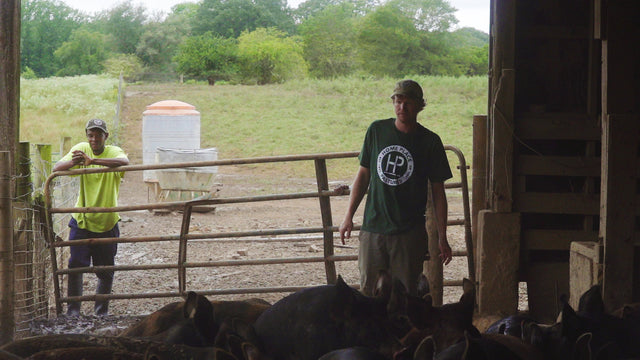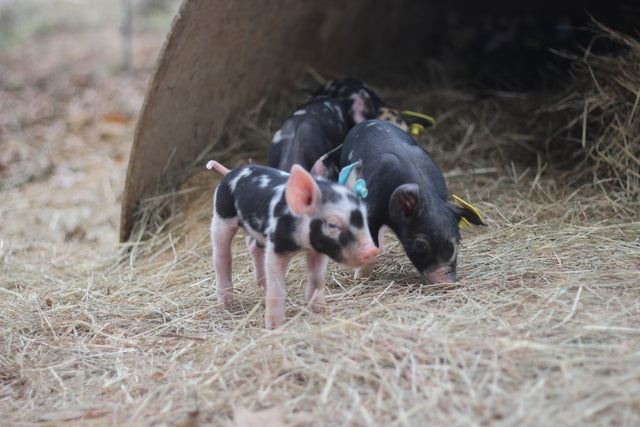
This week, I’m going to share with you today’s events while they are still fresh. I hope these posts aren’t all describing misfortunes and difficulties, but misfortune and difficulty are common guests at Home Place Pastures; they love to hang around farms.
I have a growing pile of paperwork on my desk, so I planned to spend almost the entire day in the office. Although this rarely pans out, I cling to an insane optimism that today will be different...
After about an hour behind my desk, Ashlynn, our farm manager, called me and rather frantically asked for help at the sow pasture. I threw on my muck boots and rushed out.
In these very hot summer days, hogs have difficulty cooling off. Because we are overdue for rain, the wallows they’ve made are drying up. The hogs lay in the shade and pant, but they want a mudhole, always. I can’t blame them and we do our best to accommodate. If we don’t, they accommodate themselves, usually by digging a hole under the concrete pad their water fountain mounts to, and forcing water out of the fountain with their snouts until the excess water flowing off the edge of the pad fills the hole. Pigs are innovative in this way.

While I respect their resourcefulness, this inevitably causes trouble.The problems arise when 1) they tunnel so deeply they reach the supply line buried under the concrete, and break it (problem for us, the hogs are thrilled), or 2) when a particularly ambitious sow roots and wallows to a such a degree that she mires herself in a mud trap of her own making.
Scenario Two is way worse, but also very rare. When it does happen - as it did today - it's a tricky problem to tackle. First, the ~500lb sow is fully alert and not impressed with our good intentions. She tries to bite every chance she gets because she feels cornered, which of course she is. Secondly, the sludge in which she’s imprisoned herself is filled with mud, urine, and feces that has a consistency of brownie batter (but lacks the pleasant aroma). The depth in this case was over my almost knee high muck boots.
We finally got her out, without hurting her or losing a hand, using some impressive ingenuity, a wide tow strap, and our skid steer. We achieved this not before a nearby sow defecated into the mud, atop the trapped sow, exactly where I had to put my hands. This took place in the five minutes it took me to walk to the side-by-side and grab the tow strap. Upon my return, I scooped a handful of this fresh deposit before I realized it was there. Instantly enraged, my mind raced through the countless incidents in which animal dung miraculously appears right where I have to put my hands. Combined, these “encounters'' have me suspicious of a farm-wide animal conspiracy to get crap on my hands by any means necessary. Crap and fire ants (get to that later). Anyways, we filled in the hole with old concrete chunks we keep around for this purpose. The sow was a bit sore initially but quickly recovered and showed no signs of discomfort (or gratitude) within an hour.

As soon as we’d cleaned up a bit, Ashlynn mentioned the second problem resulting from these seasonal sow excavations in a different paddock. Here we had Scenario One: the sow had tunneled to and broken the supply line. The whole area was a flooded muddy mess littered with contented swine.
We moved the hogs to another paddock, turned off the water, dug a trench to drain off the water, and used a bucket to scoop out the mud to access and repair the broken line. Hot, sweaty, covered in mud, and pretty frustrated with hogs, I reached down into a hole containing the valve to turn the water back on. Inexplicably, infuriatingly, incredibly, and unbeknownst to me, this hole, which I had my arm in a mere hour before to turn off the water, was now filled with fire ants. No ants had been there when I turned the damn thing off, and now my hand and arm were covered in them! I strung together a torrent of obscenities that made the hogs blush, but cooled off when I realized that the repaired water line was NOT leaking. We packed sand and dirt around the repaired line to support it before burying it with the larger chunks of excess concrete. I also noticed the ants in the hole were eating an unlucky insect that had fallen inside. I guess that explains it? Anyway, both sow problems were solved for now.
I made it back to the office, filthy and odorous, just in time for a scheduled conference call at 3 pm. I sat as far as I could from Sam, our Chief of Operations, and silently mouthed an apology.
Frustrations aside, today really made me consider our sow setup in the midst of these extreme temperatures and high humidity. Heat induces daily stress which can affect sow health, fertility, feed intake, body condition, milk production, and fetal development. Their destructive behavior represents nothing more than an attempt to cool off. We have plenty of shade and cool drinking water in these paddocks, but I need to add a timed sprinkler system during these months to allow ample cooling and keep wallows where I want them (away from water lines). This will involve digging down to the water line in strategic locations and plumbing in hydrants for attaching the sprinklers and timers. A lot of work and some money, yes, but a full day's labor fixing water lines and liberating sows isn’t exactly cost efficient. This addition will leave us with a better system for the rest of this summer and summers to come.
I try to steer thoughts on these struggles toward examining the root issues in our production systems. The sows are too hot so they are tearing up our infrastructure and getting stuck in mudholes. Simple as that. To be better at managing sows, and to keep me in the office every now and then, I’ve got to find a better way to cool them off in addition to fixing the immediate tunneling issue. And so farming goes, everyday, forever. Small improvements and lessons learned each day build upon one another. I’ve accepted that there is no end point, but I do take pleasure in reflecting on how far we’ve come in six years. I hope to feel the same in six more.
More stories

A Day in the Life of Home Place

